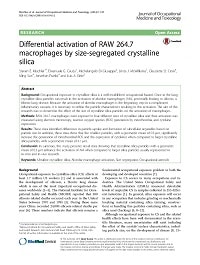Mining Publication: Differential Activation of RAW 264.7 Macrophages by Size-Segregated Crystalline Silica
Original creation date: December 2016
Authors: SE Mischler, E Cauda, M Di Giuseppe, LJ Mcwilliams, C St. Croix, M Sun, J Franks, LA Ortiz
Occupational exposure to crystalline silica is a well-established occupational hazard. Once in the lung, crystalline silica particles can result in the activation of alveolar macrophages (AM), potentially leading to silicosis, a fibrotic lung disease. Because the activation of alveolar macrophages is the beginning step in a complicated inflammatory cascade, it is necessary to define the particle characteristics resulting in this activation. The aim of this research was to determine the effect of the size of crystalline silica particles on the activation of macrophages.
RAW 264.7 macrophages were exposed to four different sizes of crystalline silica and their activation was measured using electron microscopy, reactive oxygen species (ROS) generation by mitochondria, and cytokine expression.
These data identified differences in particle uptake and formation of subcellular organelles based on particle size. In addition, these data show that the smallest particles, with a geometric mean of 0.3 µm, significantly increase the generation of mitochondrial ROS and the expression of cytokines when compared to larger crystalline silica particles, with a geometric mean of 4.1 µm.
In summary, this study presents novel data showing that crystalline silica particles with a geometric mean of 0.3 µm enhance the activation of AM when compared to larger silica particles usually represented in in vitro and in vivo research.

- Analysis of the Silica Percent in Airborne Respirable Mine Dust Samples from U.S. Operations
- Control of Respirable Dust
- Deposition Uniformity of Coal Dust on Filters and its Effect on the Accuracy of FTIR Analyses for Silica
- Filter Media and Holder Compatible with Personal Dust Monitor and End-of-Shift Crystalline Silica Quantification by Raman and FTIR Spectroscopy
- Investigation into Dust Exposures and Mining Practices in Mines in the Southern Appalachian Region
- Reducing Silica and other Respirable Hazards in the Industrial Minerals and Metal/Nonmetal Mining Industries
- Respirable Dust
- Silica Adds to Respirable Dust Concerns: What If You Could Know the Silica Dust Levels in a Coal Mine After Every Shift?
- Silica...It's Not Just Dust
- Using Real-Time Respirable Dust Monitors to Address the Silica Health Hazard in Mining